|
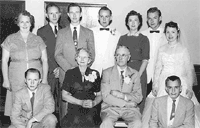 Born in Kaukauna, Wisconsin on December 31, 1923, the
third in a family of nine to Dora Harriet (Ebben) and Lawrence August
Steffens. Lawrence supported the family with his job at Appleton
Coated Paper Company where he operated a paper machine in the mill.
Appleton Coated Paper was only 6 blocks away, so he walked to and from
work every day. Chuck had three sisters and five brothers
(Cecilia, Ed, Margie, Florian, Mary, Larry, Eugene, Ken). Even
though his mother always called him "Charles" throughout her
entire life, as a child and growing up he was "Chuck" to
everyone else. Born in Kaukauna, Wisconsin on December 31, 1923, the
third in a family of nine to Dora Harriet (Ebben) and Lawrence August
Steffens. Lawrence supported the family with his job at Appleton
Coated Paper Company where he operated a paper machine in the mill.
Appleton Coated Paper was only 6 blocks away, so he walked to and from
work every day. Chuck had three sisters and five brothers
(Cecilia, Ed, Margie, Florian, Mary, Larry, Eugene, Ken). Even
though his mother always called him "Charles" throughout her
entire life, as a child and growing up he was "Chuck" to
everyone else.
Chuck was born on a farm and lived there for his first
4 years. Chuck’s father had the farm taken away from him and
given to Lawrence’s older brother, who was in better favor with
Lawrence’s parents when Chuck was 4. They then moved to a
house on Superior Street where they lived for the next 5 years.
In 1931, Lawrence bought a large 60 year old house on
Wisconsin Avenue across the street from Fox Riverside / St. Joseph’s
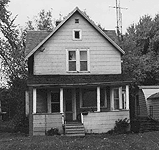 cemetery. The house was huge with a full basement, main floor
with large kitchen and had 7 bedrooms (6 upstairs and 1 downstairs),
ample space for the family to live in. The
house deal was sealed for $1,500 with one stipulation: the house was to
be moved across the street! That money also paid for a
contractor to build a basement foundation across the street, lift the
old house out of it’s original location, move it across the street
to the new foundation, do the electrical wiring, drill a well and pour
a concrete driveway. Into the relocated house moved the current
Steffens clan, Dora and Lawrence, nine kids, two grandmothers and
Uncle Leo. It seems Uncle Leo (Lawrence’s brother) lent him
$500 several years back and in return he lived with them for 11 or 12
years, well beyond the worth of the loan.
cemetery. The house was huge with a full basement, main floor
with large kitchen and had 7 bedrooms (6 upstairs and 1 downstairs),
ample space for the family to live in. The
house deal was sealed for $1,500 with one stipulation: the house was to
be moved across the street! That money also paid for a
contractor to build a basement foundation across the street, lift the
old house out of it’s original location, move it across the street
to the new foundation, do the electrical wiring, drill a well and pour
a concrete driveway. Into the relocated house moved the current
Steffens clan, Dora and Lawrence, nine kids, two grandmothers and
Uncle Leo. It seems Uncle Leo (Lawrence’s brother) lent him
$500 several years back and in return he lived with them for 11 or 12
years, well beyond the worth of the loan.
Chuck went to St. Therese Elementary school in Appleton, growing up
Catholic. Chuck’s teenage years were hard ones, working all of
his spare time to pay for food for the family table. At 14, when
Chuck started high school, he began working at Bellins Grocery Store
(a block from home) for 15 cents an hour, about 75 hours a week after
school and on weekends. Of his $12-15 a week wages, Chuck never
saw a penny, just a receipt stamped with the date and the words
"Paid on Account". During his sophomore and junior
years at Appleton High School, on summer break from school, Chuck
worked on his uncle’s farm 14-16 hour days, seven days a week,
harvesting the fields, pitching 50 pound bales of corn heaves onto a
flatbed tractor, milking the cows and other tedious, back breaking
chores. Again Chuck never saw any actual money from his labor,
his farm work paid the meat and egg bill for the family for the year.
Chuck never had any time to develop any interest in sports or any
lasting childhood friendships. His brothers Ed, Larry and Eugene
also worked long hours at a dairy while growing up to help support the
family.
The hard labor and exhaustion finally took it’s toll as Chuck was
diagnosed with Polio during the beginning of his senior year of high
school. From September through January, he attended classes but
was excused from doing homework while recovering from his illness.
The Polio eventually settled in his left hand. With not enough
strength to continue his job at the grocery store, Chuck took a job at
the local bowling alley originally as a "pin setter".
Before his first day of work, the manager of the bowling alley,
sympathetic to Chuck’s weakened condition, changed his job to
watching the foul line as bowlers delivered the ball down the alley.
He sat in a box, raised high above the floor and rang a bell and
switched on the associated alley’s foul light when a bowler crossed
the foul line.
During Chuck's high school years, his father Lawrence suffered a
devastating industrial accident at the Appleton Coated Paper Mill that
he worked at. At the mill they stacked large several hundred
pound rolls of paper on their side and piled them 6 or 7 high.
One day a pile of poorly stacked paper rolls fell over while Lawrence
was walking by and he was crushed by them breaking dozens of bones and
leaving him in the hospital for many weeks. Much of the hardship
was forced upon Chuck and his brothers by his father's accident
bearing the load of supporting the family while his father healed
and was rehabilitated.
After high school in 1941, Chuck attended Kaukauna Vocational
School where he studied metal work and graduated with a mechanics
license. This landed him a job at Marathon Paper Company working
to fashion a metal armature that sealed bombs for the war effort.
Every company during the war had to set aside a certain amount of
it’s resources to providing some service to America’s WWII
involvement. The portion of Chuck’s 60 cents a hour that his
parents let him keep seemed like a fortune to him and was the first
money he ever earned that he was able to put in his pocket.
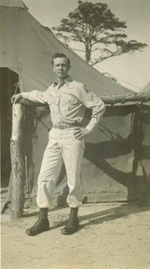 At
nineteen, in 1942, Chuck was drafted in the Army-Air Force. His
first job was as an office manager maintaining the records for all
personnel stationed at Fort Dix, New Jersey. From there Chuck was
transferred all around the country to 13 other locations before he
finally left the service (Ft. Sheridan, IL (just outside Chicago),
Cape May, NJ, Washburn Island, MA, Tallahassee, FL, Miami Beach, FL,
Lincoln, NE, Kearns, UT, Fort Bliss, MO, Albuquerque, NM and Camp
Humboldt, CA). Several times, Chuck was sent to deportation
locations to serve overseas, but each time his Polio problems kept him
stateside. In Miami, Chuck took a test and physical to join the
Air Force but failed the physical due to his shaking (Polio) left
hand. In late 1944, Chuck re-enlisted for another year for
$1000. He finally made it to Camp Humboldt, outside San
Francisco, an Army officer’s debarkation point, where he left the
service after 46 months and 3 days (he remembered the duration of his
time to the day). From there, Chuck visited with Bud Baer’s
(his sister Margie’s husband) Aunt Serepta and her sister at their
peach and pear farm in California. He stayed with them for a
month and relaxed. Serepta and her sister eventually sold their
farm and property which was later to become a large part of Knott’s
Berry Farm and Disneyland. At
nineteen, in 1942, Chuck was drafted in the Army-Air Force. His
first job was as an office manager maintaining the records for all
personnel stationed at Fort Dix, New Jersey. From there Chuck was
transferred all around the country to 13 other locations before he
finally left the service (Ft. Sheridan, IL (just outside Chicago),
Cape May, NJ, Washburn Island, MA, Tallahassee, FL, Miami Beach, FL,
Lincoln, NE, Kearns, UT, Fort Bliss, MO, Albuquerque, NM and Camp
Humboldt, CA). Several times, Chuck was sent to deportation
locations to serve overseas, but each time his Polio problems kept him
stateside. In Miami, Chuck took a test and physical to join the
Air Force but failed the physical due to his shaking (Polio) left
hand. In late 1944, Chuck re-enlisted for another year for
$1000. He finally made it to Camp Humboldt, outside San
Francisco, an Army officer’s debarkation point, where he left the
service after 46 months and 3 days (he remembered the duration of his
time to the day). From there, Chuck visited with Bud Baer’s
(his sister Margie’s husband) Aunt Serepta and her sister at their
peach and pear farm in California. He stayed with them for a
month and relaxed. Serepta and her sister eventually sold their
farm and property which was later to become a large part of Knott’s
Berry Farm and Disneyland.
In 1946, Chuck returned home to Appleton and after a few weeks, he
decided to attend college at the Business Institute of Milwaukee
concentrating his studies on bookkeeping. On his last night in
Appleton before heading off to Milwaukee, Chuck
had a double-date with one of his younger Appleton High School
buddies, Joe Offenstein. Chuck had asked out Trudy Vermeern, a
friend of his sister Margie, and Joe had a date with a girl he
graduated from high school with in 1943, a secretary at
Kimberly-Clark. Together they went to a movie and
afterwards had a sandwich and a coke at a local diner. Chuck
and his friend’s date, Betty Hooyman,
seemed to hit it off. By a 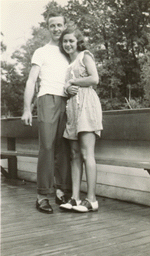 bizarre coincidence, Trudy and Betty
were friends and worked next to each other at Kimberly-Clark.
Chuck headed off to school in Milwaukee the next day, but a few weeks
later, after hitchhiking home for the weekend, he dialed up
Kimberly-Clark’s operator and asked to speak with Betty Hooyman.
After a short discussion, they agreed to meet later that night for a
drink and some dancing at a local tavern. For the next two
years, they kept in touch mainly through the mail, writing and sending
lots of letters to each other. Occasionally Chuck would
hitchhike back to Appleton (about once every 6 weeks) and he and Betty
would get together and go out on a date. Throughout this time,
Betty continued working at Kimberly-Clark, rode a bus to work every
day and was living with her mother Bertha at her sister Ginny and Alby
Bevers’ house. Alby and Ginny had been married a few years
before.
bizarre coincidence, Trudy and Betty
were friends and worked next to each other at Kimberly-Clark.
Chuck headed off to school in Milwaukee the next day, but a few weeks
later, after hitchhiking home for the weekend, he dialed up
Kimberly-Clark’s operator and asked to speak with Betty Hooyman.
After a short discussion, they agreed to meet later that night for a
drink and some dancing at a local tavern. For the next two
years, they kept in touch mainly through the mail, writing and sending
lots of letters to each other. Occasionally Chuck would
hitchhike back to Appleton (about once every 6 weeks) and he and Betty
would get together and go out on a date. Throughout this time,
Betty continued working at Kimberly-Clark, rode a bus to work every
day and was living with her mother Bertha at her sister Ginny and Alby
Bevers’ house. Alby and Ginny had been married a few years
before.
While in college, Chuck worked at the Wineberg Shoe Factory putting
tops on cardboard shoeboxes as they rolled off the machine.
After 6 months, he quit and landed a job as a night watchman at a
trucking company. Hourly he did the rounds inspecting the trucks to
see if they were still locked and that everything was all right.
This left him enough free time between rounds to do his homework.
After work, he’d catch the transit bus home to Wauwautosa where he
rented a room in a house belonging to the Soothsmith family for a year
and a half. His rent was $65 a month which included breakfast.
Uncle Sam gave retired  military servicemen $65 a month for college
education until their course of study was completed and they
graduated. During
his time in college, Chuck found time to develop some friendships and
socialize. When he wasn’t working, Chuck’s favorite
activities were indoor roller skating, fishing and meeting up with his
college friends to have a drink and dance at a local tavern.
Chuck made a few life-long friends at the Business Institute which
included Joe Peerenboom and Phil Hurst.
military servicemen $65 a month for college
education until their course of study was completed and they
graduated. During
his time in college, Chuck found time to develop some friendships and
socialize. When he wasn’t working, Chuck’s favorite
activities were indoor roller skating, fishing and meeting up with his
college friends to have a drink and dance at a local tavern.
Chuck made a few life-long friends at the Business Institute which
included Joe Peerenboom and Phil Hurst.
 On
trips back to Appleton, Chuck got in the habit of bringing Betty his
spare money, which she saved for him in a small brown envelope ($10 at
a time) at home until he was out of school. After a year of long
distance romance, in the winter of 1947, Chuck proposed to Betty one
night when they were out at the Paradise Club, a tavern in Appleton,
by simply slipping the engagement ring out of his pocket and onto her
finger. No "Will you marry me?" was necessary.
The Paradise Club is still there today, next to a mall in west
Appleton, but is now believed to be a strip club! On
trips back to Appleton, Chuck got in the habit of bringing Betty his
spare money, which she saved for him in a small brown envelope ($10 at
a time) at home until he was out of school. After a year of long
distance romance, in the winter of 1947, Chuck proposed to Betty one
night when they were out at the Paradise Club, a tavern in Appleton,
by simply slipping the engagement ring out of his pocket and onto her
finger. No "Will you marry me?" was necessary.
The Paradise Club is still there today, next to a mall in west
Appleton, but is now believed to be a strip club!
Chuck graduated at age 24 with a two year Associate degree in cost
accounting. Fresh out of school in the fall of 1948, Chuck
landed a job at Western Condensing Company as an accountant.
Chuck bought his first car for $500, affectionately named the
"Green Hornet", an ugly green Hudson with only 3 fenders.
Several months later, Chuck and Betty, took a road trip to Milwaukee
where they foraged through several junkyards until they found another
fender for the Hudson. They pitched it in the back seat and
headed back to Appleton, ecstatic to have a car with all four fenders.
Chuck had the fender painted green to match the rest of the car
and installed it … the proud owner of a whole car.
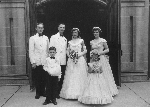 After a year and a half engagement, Chuck and Betty were married at
an early morning wedding ceremony at Saint Mary’s Catholic Church of
Appleton on August 29, 1949. The
ceremony was performed by Father Rickert, Chuck’s third cousin, and
the reception was held at the Conway Hotel Ballroom.
Immediately after the ceremony, the wedding party went back to
Chuck’s parents house for a light breakfast served by Dora. A
late breakfast was necessary back then because you weren’t allowed
to eat or drink anything before receiving communion, which was always
included in a After a year and a half engagement, Chuck and Betty were married at
an early morning wedding ceremony at Saint Mary’s Catholic Church of
Appleton on August 29, 1949. The
ceremony was performed by Father Rickert, Chuck’s third cousin, and
the reception was held at the Conway Hotel Ballroom.
Immediately after the ceremony, the wedding party went back to
Chuck’s parents house for a light breakfast served by Dora. A
late breakfast was necessary back then because you weren’t allowed
to eat or drink anything before receiving communion, which was always
included in a 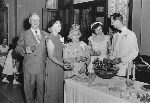 Catholic wedding. The reception was attended by
about 100 friends and relatives, who all enjoyed punch, cake, snacks
and jukebox music from 2-4pm. After
the reception, Chuck and Betty piled in the Green Hornet and drove to
a nice cottage on a beautiful lake at Eagle River in northern Wisconsin for a
relaxing week of fishing and sightseeing. They returned to their
jobs and 2 months later took another week of vacation to visit friends
at Niagara Falls and Detroit, acquaintances of theirs from Appleton
that had both been married the previous year. For many more
pictures of their engagement, wedding, reception, and honeymoon, click
here. Catholic wedding. The reception was attended by
about 100 friends and relatives, who all enjoyed punch, cake, snacks
and jukebox music from 2-4pm. After
the reception, Chuck and Betty piled in the Green Hornet and drove to
a nice cottage on a beautiful lake at Eagle River in northern Wisconsin for a
relaxing week of fishing and sightseeing. They returned to their
jobs and 2 months later took another week of vacation to visit friends
at Niagara Falls and Detroit, acquaintances of theirs from Appleton
that had both been married the previous year. For many more
pictures of their engagement, wedding, reception, and honeymoon, click
here.
Chuck and Betty had waited to get married until Chuck had
graduated, had a job and they had enough money saved up. They
paid for the wedding and reception themselves and moved into an
apartment in Menasha (half way between Neenah and Appleton).
They used the rest of their savings to buy all new furniture for their
apartment, get settled and started their first bank account with $1000
in cash. In the apartment next to theirs, their neighbors were
another young couple, Audrey and Marty Phalen. They became good
friends and the four of them had a lot of fun together. Betty
and Marty worked at Kimberly-Clark’s Neenah main office and caught
the local bus each 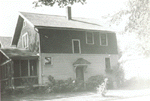 day to work together. Chuck and Audrey both
worked in Appleton and drove in their own cars. Chuck and Betty lived
in the apartment for a year and managed to save up $1800, enough for a
down payment on their first house. Their
new address was on Rankin Street in northeastern Appleton near
Lawrence College. It was a 1920’s style, two story house with
an open staircase, three bedrooms upstairs and a bathroom with an old
claw foot bathtub. They remodeled the bathroom, adding in all
new cabinets, removed the old claw foot tub and added the new built-in
style tub under the bathroom window. day to work together. Chuck and Audrey both
worked in Appleton and drove in their own cars. Chuck and Betty lived
in the apartment for a year and managed to save up $1800, enough for a
down payment on their first house. Their
new address was on Rankin Street in northeastern Appleton near
Lawrence College. It was a 1920’s style, two story house with
an open staircase, three bedrooms upstairs and a bathroom with an old
claw foot bathtub. They remodeled the bathroom, adding in all
new cabinets, removed the old claw foot tub and added the new built-in
style tub under the bathroom window.
When they moved from their apartment to the Rankin Street house,
Betty was pregnant with their first son. About a month before
they moved, Bruce was born on October 6, 1950 at the hospital in
Neenah. A few months before Bruce was born, Betty had to quit
her job at Kimberly-Clark after 7 years of working there. Women
back then were not allowed to work once they were more than 7 months
pregnant. While a little frightened by the sudden loss of income
with Betty not working, they were delighted to be starting a family.
Their second son, David, was born a couple of years later on a
sunny day at noon on June 29, 1952 at the same hospital in Neenah.
At birth, Dave weighed nearly 9 pounds and Betty often joked about how
she lost 18 pounds over a lunch hour. --2--
They lived in their Rankin Street house for two years,
bought it for $8,000 and sold it in late 1952 for $10,000. Chuck
bought 2 lots on Frances Street in a brand new neighborhood for $500 a
piece from Eric Krick, a builder and friend through Betty’s side of
the family. John and Marcie Groudamon (friends of Chuck and
Betty), after much discussion talked Chuck into selling the second lot
to them for cost. Chuck took out a 3 month
"construction" loan and had the Frances Street house built
from the ground up, with his own design, doing all the subcontracting
himself. The
basement was dug on August 15, found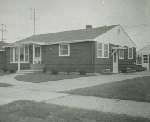 ation poured and the structure
began to take shape. During this time, Chuck finished work at
5:00pm each day and after supper and on weekends would finish up
whatever construction work he could. He painted the house
himself and they moved in on November 15, three months later.
The Frances Street house had 7-8 foot ceilings, three bedrooms,
kitchen, living room and dining room upstairs and a cement block
shower, play room and a work room in the basement. It had a
double car garage with a play house (a porch enclosed with windows) on
the side. Chuck built the windows himself, taking a night course
at school to learn how to make them. In the playroom, they had
one wall where Chuck mounted a large slate blackboard that they
purchased from a school going out of business. ation poured and the structure
began to take shape. During this time, Chuck finished work at
5:00pm each day and after supper and on weekends would finish up
whatever construction work he could. He painted the house
himself and they moved in on November 15, three months later.
The Frances Street house had 7-8 foot ceilings, three bedrooms,
kitchen, living room and dining room upstairs and a cement block
shower, play room and a work room in the basement. It had a
double car garage with a play house (a porch enclosed with windows) on
the side. Chuck built the windows himself, taking a night course
at school to learn how to make them. In the playroom, they had
one wall where Chuck mounted a large slate blackboard that they
purchased from a school going out of business.
After a few years, Chuck’s job at Western Condensing in the
Accounting Department gave him a unique career opportunity. In
the spring of 1952, Chuck was asked to launch a time and motion study
project and was then sent to the various plants of Western Condensing
to take data on various jobs performed in those factories. This
new position lasted several months and when it was over Chuck was
rewarded by being laid off. It seems his previous position in
the Accounting Department had been filled and they no longer had a
place for him. Chuck quickly found 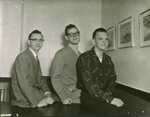 another job as an office
manager for a local equipment wholesale company. In late 1952
Western Condensing hired Chuck back. After
being there about 10 months, his boss, Fred Bock decided to start up a
"data processing" department. They purchased a
"tabulating machine" which was a 10 by 20 foot computer that
performed repetitive computations from a "perforated board"
that was programmed by connecting wire cables across holes in the
board. In 1953, after six weeks of lessons and one week of
computer training, they made Chuck a data processing manager.
His new position had him setting up computers in all the mills and
training the bookkeeping staff to program and use them. another job as an office
manager for a local equipment wholesale company. In late 1952
Western Condensing hired Chuck back. After
being there about 10 months, his boss, Fred Bock decided to start up a
"data processing" department. They purchased a
"tabulating machine" which was a 10 by 20 foot computer that
performed repetitive computations from a "perforated board"
that was programmed by connecting wire cables across holes in the
board. In 1953, after six weeks of lessons and one week of
computer training, they made Chuck a data processing manager.
His new position had him setting up computers in all the mills and
training the bookkeeping staff to program and use them.
When Western Condensing sold out to Foremost Dairy in late summer
1955, Chuck was offered a transfer to
another plant north of San Francisco, which he turned down and was
therefore forced to quit. He applied for a job at
Kimberly-Clark, but had to wait for several months for a job in their
bookkeeping department to open up. Chuck was hired by Kimberly-Clark
in the fall of 1955. He took a qualifying test along with
several other men to be a part of Kimberly-Clark’s new Data
Processing Department and scored at the top of his group. 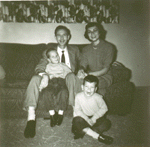 Shortly after, he was sent to Chicago for 2 weeks of Data Processing
instruction in December, driving home on weekends. After his
classes were over, Chuck was offered a transfer to a new position at
K-C’s Memphis, Tennessee plant to help start up a new Data
Processing Department to manage the Paper Products Division there.
He quickly accepted the promising career move. They
sold their brand new house and Kimberly-Clark had a moving company
pack up the entire contents of the house and load it on the van. Chuck
and Betty sold the Green Hornet, bought a new white and tan Chevrolet
station wagon and loaded up their personal items, the kids, and were
on their way to a bigger and better lifestyle. Bruce was 4 years
old and David was 2. K-C gave them a moving allowance and when
they arrived in Memphis, put them up in a two bedroom apartment for
about 6 months while they looked for a suitable home.
--3-- Shortly after, he was sent to Chicago for 2 weeks of Data Processing
instruction in December, driving home on weekends. After his
classes were over, Chuck was offered a transfer to a new position at
K-C’s Memphis, Tennessee plant to help start up a new Data
Processing Department to manage the Paper Products Division there.
He quickly accepted the promising career move. They
sold their brand new house and Kimberly-Clark had a moving company
pack up the entire contents of the house and load it on the van. Chuck
and Betty sold the Green Hornet, bought a new white and tan Chevrolet
station wagon and loaded up their personal items, the kids, and were
on their way to a bigger and better lifestyle. Bruce was 4 years
old and David was 2. K-C gave them a moving allowance and when
they arrived in Memphis, put them up in a two bedroom apartment for
about 6 months while they looked for a suitable home.
--3--
Chuck and Betty finally found a brand new house in Memphis that was
already built but not quite finished in the central part of town.
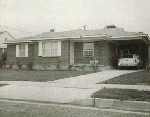 They
were able to choose the interior layout and colors. Chuck chose
to have the deep carport modified and use half of it for a den in
which he installed dark wood paneling and made a built-in model train
track that pulled down from one wall. The home improvement fever
struck again, Chuck poured and leveled a cement slab for a backyard
patio on top of which he meticulously cut and mortared in a unique
brick design using brick to match the house. He then added a
lean-to area onto the back of the garage which he turned into a 20x10
foot storage room. The Walter Street house was only a few blocks
from St. James Catholic Church and School. Bruce would soon be
starting grade school and the walk to school for the kids would prove
to be very convenient over the next several years. Chuck had
about a 15 mile commute to the K-C plant in the far northern part of
the city. They
were able to choose the interior layout and colors. Chuck chose
to have the deep carport modified and use half of it for a den in
which he installed dark wood paneling and made a built-in model train
track that pulled down from one wall. The home improvement fever
struck again, Chuck poured and leveled a cement slab for a backyard
patio on top of which he meticulously cut and mortared in a unique
brick design using brick to match the house. He then added a
lean-to area onto the back of the garage which he turned into a 20x10
foot storage room. The Walter Street house was only a few blocks
from St. James Catholic Church and School. Bruce would soon be
starting grade school and the walk to school for the kids would prove
to be very convenient over the next several years. Chuck had
about a 15 mile commute to the K-C plant in the far northern part of
the city.
In late 1956, Betty again became pregnant with their third child.
Fully expecting a daughter, they had planned the name Sue Ellen for
their latest edition to the family. A month after moving into
their new house, they were surprised with a third son mid-day on July
8, 1957. They quickly changed the intended name to Alan, the
closest name to Sue Ellen that Betty could think of at the time.
--4--
The move to Memphis was an exciting and busy time for Chuck and
Betty. With 3 young children they had a lot in common with
couples their age and K-C had many planned social activities, so they
quickly adapted to the new city and job. They took lessons and
joined a bridge club, became involved with school groups and made many
new friends. They linked up with the Phalens again, when Marty
accepted a job transfer to the Memphis K-C plant a few months later.
By this time, the Phalens had 3 children of their own and a lot of fun
family times were spent together with them. --5--
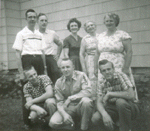 Vacations for the Steffens family during this time alternated between
trips to Appleton to visit family and road trip adventures seeing the sights
across our great country. Chuck and Betty packed up the brown
and white paneled Chevy station wagon and took the kids to Florida,
Washington, DC, the Chesapeake Bay, Gettysburg and Georgetown,
WV. With most of Chuck and Betty's family still centered
in Wisconsin, vacations there usually meant family reunions in Neenah
and weekends at relatives cabins on various lakes across the
"Dairy" state. It seemed like everyone there had a
lakefront cabin for weekend getaways, and many hours were spent
fishing, playing canasta and sheephead (traditional mid-west card
games), and having beers around the fireplace. Vacations for the Steffens family during this time alternated between
trips to Appleton to visit family and road trip adventures seeing the sights
across our great country. Chuck and Betty packed up the brown
and white paneled Chevy station wagon and took the kids to Florida,
Washington, DC, the Chesapeake Bay, Gettysburg and Georgetown,
WV. With most of Chuck and Betty's family still centered
in Wisconsin, vacations there usually meant family reunions in Neenah
and weekends at relatives cabins on various lakes across the
"Dairy" state. It seemed like everyone there had a
lakefront cabin for weekend getaways, and many hours were spent
fishing, playing canasta and sheephead (traditional mid-west card
games), and having beers around the fireplace.
In 1965, with the Walter Street house now completely paid for,
Chuck and Betty decided it was time to move out of the city.
They helped design and had a house built in a new subdivision in a
northeastern suburb of Memphis known as Raleigh, much closer to
Chuck’s work.
 The
Kenneth Street house was another rambler with 3 bedrooms, a nicer
layout and a bigger yard with lots of fields and wooded areas nearby
for the children to play in. The house was completed and the
family moved in during the spring of 1965. Alan began attending
St. Anne’s Catholic School in Raleigh in the middle of third grade,
David was in eighth and Bruce was a sophomore at Catholic High School.
Chuck and Betty became landlords renting out the Walter Street house
after the move. The
Kenneth Street house was another rambler with 3 bedrooms, a nicer
layout and a bigger yard with lots of fields and wooded areas nearby
for the children to play in. The house was completed and the
family moved in during the spring of 1965. Alan began attending
St. Anne’s Catholic School in Raleigh in the middle of third grade,
David was in eighth and Bruce was a sophomore at Catholic High School.
Chuck and Betty became landlords renting out the Walter Street house
after the move.
Many summer weekends during this time were spent taking trips to
the Tennessee River and staying at a small hunting cabin that Chuck
and Betty rented there. It was about an hour drive from Raleigh
and Chuck bought a small aluminum boat which they towed behind their
newer blue Chevy station wagon. The cabin was a small one room
affair, which was quickly filled up with 2 double beds and a folding
army cot which Alan slept on. The kids found out quickly
how hard it was to deal with Chuck’s snoring. Days were spent
fishing and David and Bruce would target practice with a fellow cabin
neighbor’s gun at tin cans in the woods. Alan was duped one
night with the old "snipe hunt" gag, standing for hours
outside with a burlap sack waiting for one of the fictitious critters
to show up. One summer, Chuck developed a personal vendetta with
a mouse that shared the cabin with us. With mouse traps set
up at strategic locations all about the place, and after several
months of cohabitating with the rodent, we were all woken up in the
middle of the night by the sound of a trap being tripped and Chuck
screaming "I got him, I got him!" --6--
Betty began working again as a secretary for the Dean of Men at
Southwestern College. She inherited the Chev station wagon when
they bought a new Volkwagen Beetle, and they became a two car family.
As time went by, Chuck became more and more discontent with the
management at Kimberly-Clark in Memphis, the company growth, and the
rapid changes in the Data Processing Department there. In April
of 1969, K-C approached Chuck with a DP department management position
in a smaller subsidiary of K-C in Dayton, Ohio known as Karolton
Envelope. Chuck immediately agreed to the transfer, without
really considering how Betty or the children felt about the idea.
This was a very traumatic time for the family as they all struggled
with the idea of another move after 13 years of putting down roots in
Memphis. Chuck left soon after that, with Betty and the rest of
the children staying behind to sell both houses and waiting for the
school year to end. --7--
Chuck moved into a small apartment in Miamisburg (southeastern
suburb of Dayton) for 3 months with the rest of the family still in
Memphis. Bruce joined him shortly afterwards, landing a job in
the Karolton Envelope paper mill for the summer. Chuck put in an
offer on a four year old, three bedroom, split level house on Mad
River Road on the south side of Dayton. The house purchase
proceeded quickly and Chuck and Bruce painted the entire interior of
the new house over the next few weeks after work and on weekends.
Betty, David and Alan arrived a few weeks later. Alan started
seventh grade at St. Henry’s and David finished off his high school
senior year at Alter High School. Bruce, after a year at
Southwestern College in Memphis, was glad to be starting as a
sophomore in the Engineering program at the University of Dayton.
--8--
I will fill in
the Dayton portion of the biography (1968-1977) from my notes as I
find the time to do so. I'll go through Betty's many scrap books and
scan any appropriate pictures in. The following was written on the Sunday night preceding
Chuck’s funeral in an attempt to finish his story so we
could post it at the funeral home and at the church service for friends and
family to read.
In late 1977, Kimberly-Clark presented Chuck with an opportunity to
transfer back to the Neenah plant. Enamored with the idea of being
back “home” with their family and life-long friends, but
anguishing over
leaving Alan on his own at
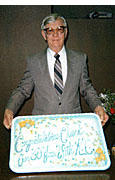 age 19 back in Dayton (in
his second year of college there). After much discussion they decided
that heading back to Wisconsin was the right move. Bruce and
David had long since graduated from college, moved out of the house,
married, and had begun their careers. age 19 back in Dayton (in
his second year of college there). After much discussion they decided
that heading back to Wisconsin was the right move. Bruce and
David had long since graduated from college, moved out of the house,
married, and had begun their careers.
Back in Appleton, Chuck (now at age 54) worked as a data processing
analyst in the finance department at K-C. They rented a duplex
on West Browning Street and moved right in upon arrival in Appleton.
Six months later they purchased both sides of the duplex from the
owner, they became landlords again, renting out the other half.
Shortly after moving back to Appleton, Betty interviewed at K-C for a
secretarial position in their legal department, got the job, and she
and Chuck carpooled together to work for the next 8 years. Chuck
retired at age 62 in January 1986 after 30 years of service to the
company (Neenah, Memphis, Dayton, and back to Neenah) with 6 months of
vacation saved up.
Chuck now unencumbered by work responsibilities wanted to spend his
winters in Florida fishing, golfing, and relaxing. Betty
continued to work until June, when she retired also and they cleaned
up their Appleton duplex in preparation for their Florida winters.
They drove down to Fort Myers, Florida and stayed a few weeks with
Betty’s sister Ginny and her husband Alby, who had been already
wintering down there for about 10 years. They showed Chuck
and Betty the ropes, and before returning to Appleton they made
arrangements to rent a condo in Punta Gorda, a nearby town for the
following winter. Over the next 7 winters Chuck and Betty rented
several different condos in various complexes around Punta Gorda,
finally settling on and purchasing the one at Gateway Point
across from Fisherman’s Village in 1993.
In early May 1993 while visiting their son Bruce (who was now
living in Orlando, Florida), Chuck suffered his first stroke in his
sleep one night. The end result was to leave Chuck without
proper eyesight in his right eye and taking away his sense of balance.
They returned directly back to Appleton and Chuck went through 3
months of physical therapy during which time he “learned” to walk
again reasonably well. His eyesight would never again be normal.
They continued to winter in Florida and summer in Wisconsin,
cherishing time with family and friends in both locations. They
relaxed playing bridge, golfing, fishing, socializing, and
frequently visited their sons and families in Orlando, Florida
(Bruce), Dayton, Ohio (David) and Seattle, Washington (Alan).
Chuck continued to suffer mini-strokes (known as TIAs) and had a
debilitating fall from a ladder while painting his Wisconsin house in
July 1999, conking his head on the cement driveway in the process.
Betty decided to leave the paint on the driveway as a reminder of the
mishap which proved to be another major setback to Chuck. Chuck’s teenage bout with polio in his left hand had
been slowly catching up with him, causing him further frustration with
dexterity and its use. By the winter of 2000, his balance and
speech were heading downhill quickly and his mobility and
communication skills had become very restricted. Betty was
determined to care for him throughout all the falls, his good days and
bad days, and daily cleaned up Chuck’s “paths of destruction”
within their two residences. Chuck throughout most of this kept
his sense of humor and stubbornly continued to try to prove his
independence and maintain his dignity.
On Friday March 22nd, 2002, Chuck suffered his final stroke, and
was hospitalized through the weekend at Charlotte Regional Medical Center
near their home in Punta Gorda. He awoke and pulled out of his
confusion for a few good days and had conversations with family
members, even joking with his nurses, before mortality finally caught
up with him on Wednesday morning March 27th. He passed away
peacefully with Betty and his son Bruce holding his hands and
comforting him through his final moments. His sons David and
Alan, and daughter-in-law Cathy walked in the room moments later.
Chuck was loved by all his family and will always be remembered as a
somewhat private person, hard working, dedicated, and a wonderful
husband, father, brother, and friend by all who crossed his
path during life.
--2-- Birth
and/or baby pictures of Bruce and David?
--3-- Pictures
of K-C group in Memphis, apartment in Memphis, on the move to Memphis?
--4-- Birth and/or baby
pictures of Alan?
--5-- Pictures
of Phalens with us in Memphis?
--6-- Pictures
of Tennessee River cabin?
--7-- Picture
of family with Chev Station Wagon and VW Beetle? Picture of
Bruce and Dad on trip to Dayton?
--8-- Pictures of
Mad River Rd house, family vacations, Karolton Envelope plant?
|
|



